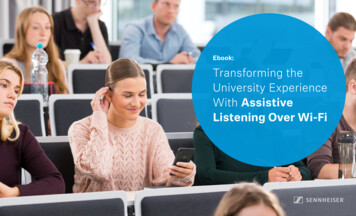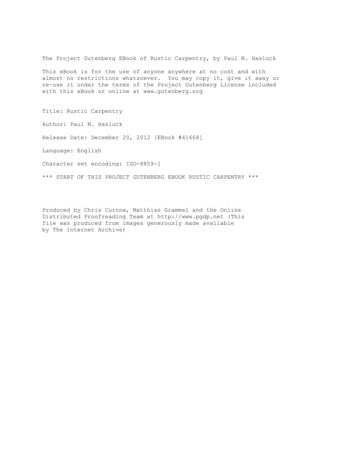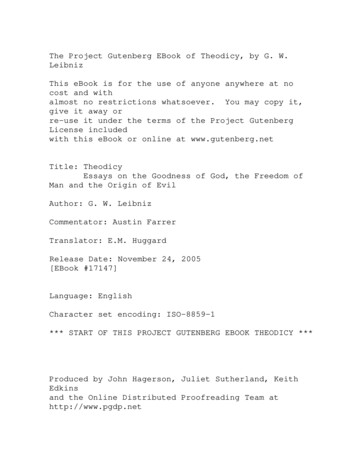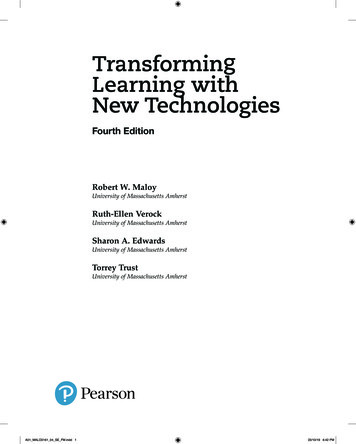
Transcription
01Ebook:Transforming theUniversity ExperienceWith AssistiveListening Over Wi-Fi
01Table ofContents1.Introduction2.An opportunity for improvement3.Accommodating hearing-impaired students4.Limitations of traditional methods5.The advent of assistive listening over Wi-Fi6.Students’ unique listening experiences7.Benefits for faculty and staff8.The potential for long-term advantages9.Sennheiser delivers assistive listening excellencewith MobileConnect10. MobileConnect success stories & awards won
0101IntroductionTraditional assistive listening technologies are often impractical fortoday’s hearing-impaired university students and run contrary to theseinstitutions’ inclusion requirements.Faculty and staff — professors, AV and IT professionals, directorsof inclusion and school leadership — are also disadvantaged by theoperational difficulties, cost inefficiencies and exclusions associated withlegacy assistive listening systems.The adoption of new technologies such as Sennheiser MobileConnectcan help students and universities surpass the limitations imposed byinduction loops, infrared and FM radio systems.Universities have the opportunity to benefit their hard-of-hearing students,mitigate health risks, cut down on bottom-line spend and genuinely enrichthe campus experience with assistive listening over Wi-Fi.
0201An opportunityfor improvementFor students who have hearing thresholds of 25-40 decibels or greater,1assistive listening technology is essential to helping them take in soundsat higher dB levels. Unfortunately, the limitations of traditional assistivelistening technology can be a significant hurdle for hearing-impairedstudents — an obstacle they should not have to clear.The world of post-secondary education is constantly evolving. With digitaltransformation affecting so many aspects of university life, it followsthat such evolution should take place in the context of higher educationinstitutions’ accommodations for students with disabilities.Given that evidence suggests easy, reliable access to Wi-Fi is students’most important tech resource for studying,2 it’s clear that listeningsolutions utilising Wi-Fi connectivity and mobile compatibility areideal for the future.These systems provide substantial benefits to students, as well asprofessors and university staff tasked with ensuring an inclusive, enrichingeducational gree-of-hearing-loss/ ng-loss/ ing-loss/ student tudent
0301Accommodatinghearing-impaired studentsTens of thousands of hearing-impaired students attend universities worldwide.They can do so because of accommodations mandated by laws like the Americanswith Disabilities Act3 and regional statutes like the EU Accessibility Directive4 and UNConvention on the Rights of Persons with Disabilities (codified in many nations’individual laws5).The World HealthOrganisation projectsa significant uptickamong hearing lossin children betweennow and 2050.6Enrollment of hearing-impaired and deaf students has risen in recentdecades, particularly the 2010s. It is reasonable to believe that furthergains in enrollment could be seen if cutting-edge assistive listeningsolutions were readily available at more universities.With the World Health Organisation projecting a significant uptickamong hearing loss in children between now and 2050, this issue’simportance is only da-tech/session/?id 110821 i COM%3A2015%3A0615%3AFIN ies.html l/deafness-and-hearing-loss
0401Limitations oftraditional methodsDiscussion is critical to learning,7 and it’s essential for hearing-impaired students toexperience it. Three traditional assistive listening methods are commonly used in universitiesto meet this need: induction loops, infrared transmission systems and FM systems.All have notable limitations, starting with limited range.8Beyond that, FM radio signals are insecure and easily disruptable.Infrastructure for induction loops requires expensive, labour-intensive installation that limits their hardware to specific parts of the classroom. They cannot be usedin adjoining classrooms or those vertically parallel to one another due tosignificant risk of interference, and each loop offers only one audio channel.With infrared systems, universities must dedicate significant time and resourcestoward use and maintenance due to their need for line-of-sight reception andlimited portability.The shortcomings of induction and infrared present situations in which hard-of-hearingstudents feel distinctly ostracised, exacerbating “feelings of loneliness, isolation andfrustration” that the WHO cites as emotional impacts of hearing loss.9 Moreover, in theCOVID-19 era, shared devices for assistive listening systems represent a health x -disadvantagesassistive-listening-devices il/deafness-and-hearing-loss
0501The advent of assistivelistening over Wi-FiDue to their aforementioned pitfalls, traditional assistive listening solutions don’tmeet the challenges of hearing-impaired students — who, quite simply, deservetechnology that does. By contrast, assistive listening over Wi-Fi overcomesthe limitations that can diminish students’ listening experiences andunnecessarily highlight disabilities.While the market for assistive listening over Wi-Fi is projected toexpand in the years to come,10 it hasn’t quite broken into themainstream: As yet, neither the National Association of theDeaf 11 or the Hearing Loss Association of America12 list it ontheir websites’ sections regarding assistive listening options(though awareness of the technology is steadily growing).Modern classroom settings are ideal for assistivelistening over Wi-Fi. It’s no longer feasible for postsecondary administrators to keep using traditionaltechnologies if they hope to serve their hearing-impairedstudents (and others who benefit from assistive listening)It’s no longer feasiblefor post-secondaryadministrators to keep usingtraditional technologies ifthey hope to serve theirhearing-impaired studentsas effectively andrespectfully as possible.as effectively and respectfully as fi es/ ogy/hat/alds/ y/hat/alds/
0601Students’ unique listeningand learning experiencesAssistive listening over Wi-Fi solutions function simply, intuitively and effectively:Professors speak into any microphone.The resulting signal travels to a station in the AV rack that broadcasts theaudio via existing local Wi-Fi.Students download an app on their mobile devices and tune into theirclassroom’s channel using headphones, cochlear implants or hearing aids.Students hear their instructors’ lessons in crystal-clear audio using their mobiles asreceivers. (This minimises the health risk that shared equipment poses in the contextof COVID-19.) Research shows that this BYOD approach offers educational benefitsincluding increased engagement and reduced key-findings
0701Benefits forfaculty and staffProfessors using assistive listening over Wi-Fi can lecture with full confidencethat all students are hearing critical lesson points and can fully participatein discussions. This also frees instructors to eschew formal classrooms anduse alternative learning spaces: student-union lounges, small performanceareas, even outdoors on the university quad, with proper preparation!AV managers have little to worry about with assistive listening overWi-Fi: The systems are easily scalable and integrate readily withexisting AV.Similar benefits apply for IT supervisors. Barring Wi-Fi or power outages,the system should run unimpeded. Performance adjustments for optimallatency and bandwidth can easily be made as needed using a software-basedmanager —but in many ways, it’s a set-it-and-forget-it proposition in terms ofdeployment, management and troubleshooting.
0801The potential forlong-term advantagesThe real impact of assistive listening over Wi-Fi is far greater than itsimmediate benefits.Universities’ diversity and inclusion directors can have the confidence ofknowing that cutting-edge assistive listening technology makes the classroomexperience so much more rewarding for hearing-impaired students onmultiple levels. Giving aid and comfort to students in this way exemplifiesthe essence of what inclusion directors do.Meanwhile, senior leadership — deans of students, chancellors and soon— can enjoy pragmatic advantages, such as low cost of installation andmaintenance of the Wi-Fi-based technology (and minimisation of touchbased health risk).Further, the school’s development of a good reputationfor excellent assistive listening accommodations canboost enrollment of hearing-impaired students.
0901Sennheiser deliversassistive listening excellencewith MobileConnectMobileConnect from Sennheiser is the definitive assistive listening overWi-Fi solution for the campus infrastructure of modern universities.Students hear lecture audio using the MobileConnect app, with up to twoclassroom sessions broadcast simultaneously from the system’s station.Unique QR codes grant access to class sessions, ensuring security.In a learning environmentwhere digital transformationis as essential as meetingthe needs of a highlydiverse student body,MobileConnect is a logical,advantageous choice.The MobileConnect app allows students to adjust the audio settingsto suit their individual hearing needs.The system’s low-latency audio routinely stays at or below 50milliseconds, even when handling up to 100 simultaneous users.According to Cisco, this latency is below the threshold at whichlip-sync breaks unications/downloads/VideoConf CH07.pdf
1001MobileConnect success stories & awards wonChristian-Albrechts-UniversityRoyal Society of MedicineThe AV responsibles of the University of Kiel went looking for a system to transmit audioThe Royal Society of Medicine hat a need for a high quality assistive listening system in asignals from one lecture theatre to another. Another aim was to use the new system to300 seater auditorium – with an easy-to install set up that doesn’t tamper with the existingremove barriers for students and guests with a hearing disability. The University of Kielinfrastructure of the auditorium. Sennheiser MobileConnect has been installed. A completelyopted for Sennheiser’s MobileConnect system. It is easy to integrate into the existing Wififlexible, easy-to install system for assistive listening over Wifi. It works on the Bring Yourand comes with an app that students can use on their own mobile device to receive theOwn Device (BYOD) concept and can be integrated in the existing wireless infrastructure.audio signal via headphones, their hearing aids or cochlea implants.“We were all amazed by the app. It is completely intuitive inits use and allows everyone to adapt the sound to theirpersonal needs.”-Stefan PaethSpecialist for event technology, University of Kiel, Germany“Being the Royal Society of Medicine, we want to be more thanjust compliant with the Equality Act 2010, we want to showthat we’re going the extra mile.”-Kevin McLoughlinAV Manager, Royal Society of Medicine
01sennheiser.comsennheiser.com/MobileConnect
Transforming the University Experience With Assistive Listening Over Wi-Fi Ebook: 01 Table of Contents 1. Introduction . The adoption of new technologies such as Sennheiser MobileConnect . Di










